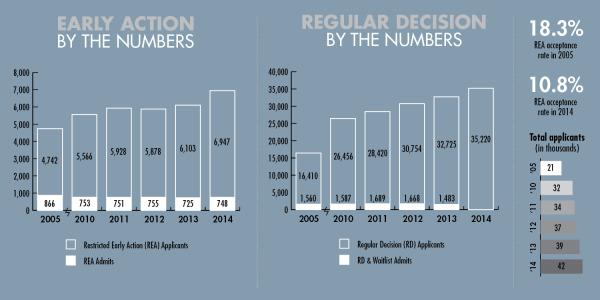Although 743 applicants have already received acceptance letters, high school seniors around the world are still waiting to hear from Stanford. But even once those decisions are released, few students know about the people making them.
Every year, as a new class enters and another one leaves, the student population is redefined, and the admissions officer is the architect of this change. Right now, Stanford admissions officers are determining next year’s shift – the Stanford Class of 2019.
For Tania Castro Bradt, Stanford Student Services manager, the chance to build each incoming class and help shape the future of Stanford offers an exciting prospect.
“The idea that you are trying to find that one kid, that one student who is really going to wow you and that you can really picture coming to this campus and bringing all of their talents and perspectives — I think that is what is exciting about being an admissions officer, that you can really help shape that community in some way,” Bradt said.
According to Irene Ibidapo, assistant director of Undergraduate Admissions, her job constantly puts her into contact with young people and their families and gives her the chance to inform them about college.
“You get to interact with great students and their families. You get to encourage people about college in general,” Ibidapo said. “They might not end up at Stanford, but you are able give them insight or help them think about this as an option for them – that college can be a place where they can go. I find it to be very meaningful work in that you are sort of helping students ostensibly change the trajectory of their lives.”
An important aspect of an admissions officer’s job is, according to Ibidapo, traveling to their respective regions. Each officer is assigned a specific area for which they read applications and educate students there about the college process. Admissions officers usually travel in the fall and in the spring, and for those like Ibidapo, whose region includes Africa, that can include international travel.
“What struck me the most when I traveled abroad was the great interest of students there who wanted to learn not just about Stanford but U.S. admissions in general,” Ibidapo said. “The U.S. does admissions differently than most of the world. We are not primarily exam-based like other areas are. We have this holistic process.”
Ibidapo went on to say that these travels also benefit the admissions officer. She believes that she is able to develop a greater understanding of her region through travel.
“Obviously when you are traveling internationally, you are traveling to different countries, so it [involves] getting a sense for where these different students are coming from, what do these places look like,” Ibidapo said. “That is very helpful in understanding the different backgrounds of these students when they write about something.”
According to Bradt, travel also entails visiting four to five high schools a day and speaking at large information sessions during the night. And by virtue of meeting so many high school students, it also means sometimes having to answer perplexing questions.
“I’ve been asked to give the historic significance of the University seal and how Stanford still lives up to its significance today, and if Stanford could be an animal, what kind of animal would it be,” Bradt said. “But most of the time, it is your typical ‘what is your deadline?’ So it varies.”
When they are not traveling and educating students and families on college and the admissions process, admissions officers are usually reading applications. According to Bradt, the reading season lasts for half of the year – starting with early action, continuing with regular decision and ending with transfer applicants.
“We spend six months out of the year reading all of these applications to find the few that are going to make it,” Bradt said. “It means that you are turning away some pretty fantastic students who unfortunately don’t always understand why they are being turned away.”

Ibidapo emphasized the importance of reading an application in the correct mindset, one that allows for a fair examination.
“I feel like a large part of our job is both an objective and subjective process,” Ibidapo said. “I mean it is a human process, so you are trying to put yourself in the shoes of the student. You are trying to understand where they are coming from, what is their story. Part of the process is to kind of detach yourself in that way so that you are not unnecessarily biasing how you read the student’s application.”
Because admissions officers spend so much time thinking about the actual person behind the application, many find Admit Weekend to be the highlight of their job.
“I get star struck,” Alana Kim Dong, assistant director of Undergraduate Admissions, said. “When you see a student who you have invested so much time in and have learned so much about through their application, seeing them in person is so exciting.”
Although the excitement doesn’t necessarily end at Admit Weekend, Dong sometimes stays connected with students well after the event.
“Seeing them matriculate and come in the fall, some of us catch up with students,” Dong said. “I’ve been fortunate enough to sort of do that… You are really proud of them, and you are happy that you got to be this minuscule part of their journey.”
Bradt also explained that many exceptional students have to be rejected. She believes that one of the hardest aspects of her job is helping these students realize that there are other options and that their rejection is not a punishment.
“[These students] are perfectly fine because you know that they are going to be great, unfortunately not here,” Bradt said. “[Y]ou have to talk to a student or family who is really disappointed about that decision and help them understand that it really wasn’t something that they did wrong.”
Bradt also spoke about unusual moments in an admissions officer’s job. Although rare, sometimes a particularly eager applicant will attempt to catch an officer’s attention with some sort of exploit.
“This student was waitlisted, and they sent a chair, a really nice chair, to the office,” Bradt said. “[They] said something along the lines of ‘I brought my own seat to the class. Please take me off the waitlist.’ Memorable sure, but things like that don’t really sway.”
The cyclical nature of admissions can seem imposing, with a seemingly overwhelming number of applications to read and the knowledge that most students are going to be rejected. Yet, for many admissions officers, the pros can outweigh the cons.
“It is humbling; it is awe-inspiring; it is never boring,” Dong said. “I mean the whole cycle of the year always keeps you on your toes, and there is always that potential of finding these incredible students from a worldwide pool. That kind of access into the great young minds of today is something that would be hard to come across in another kind of situation.”
Contact Sam Reamer at sreamer ‘at’ stanford.edu.
